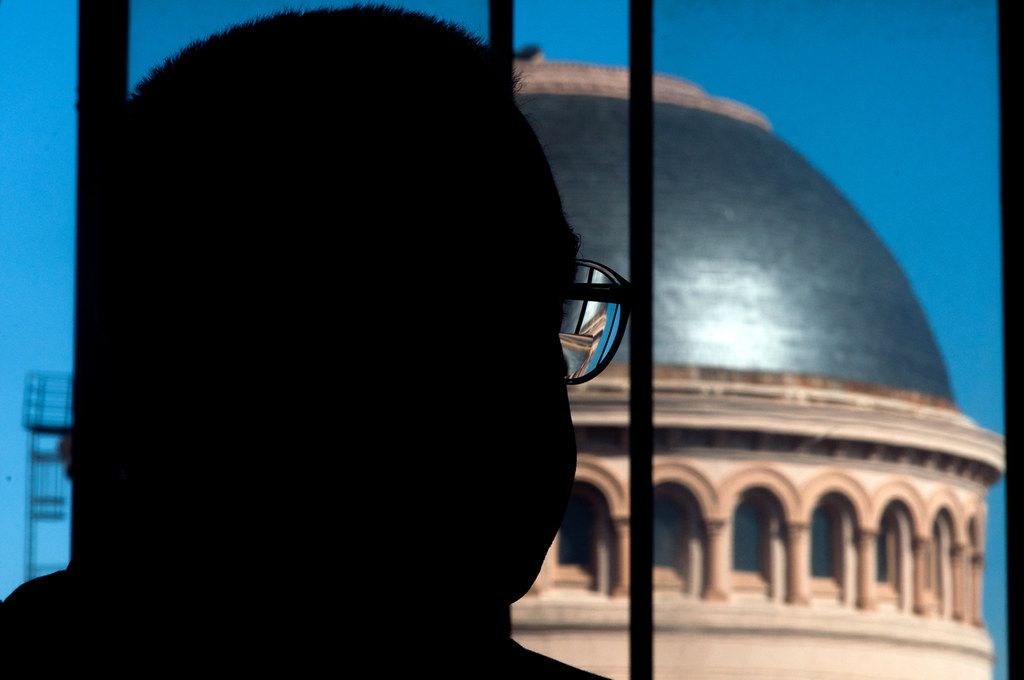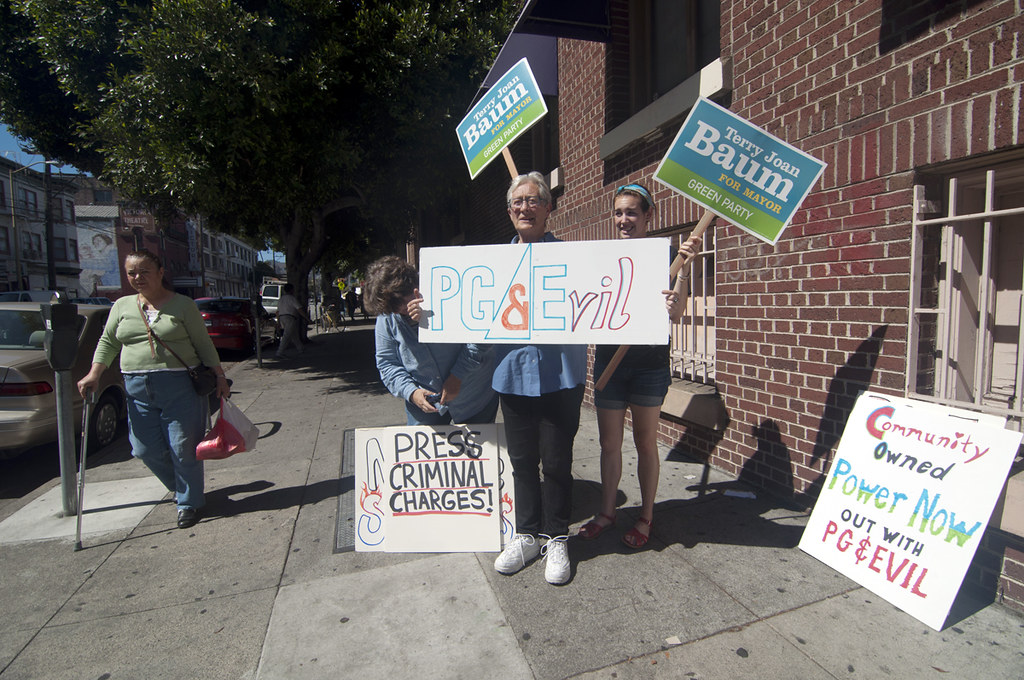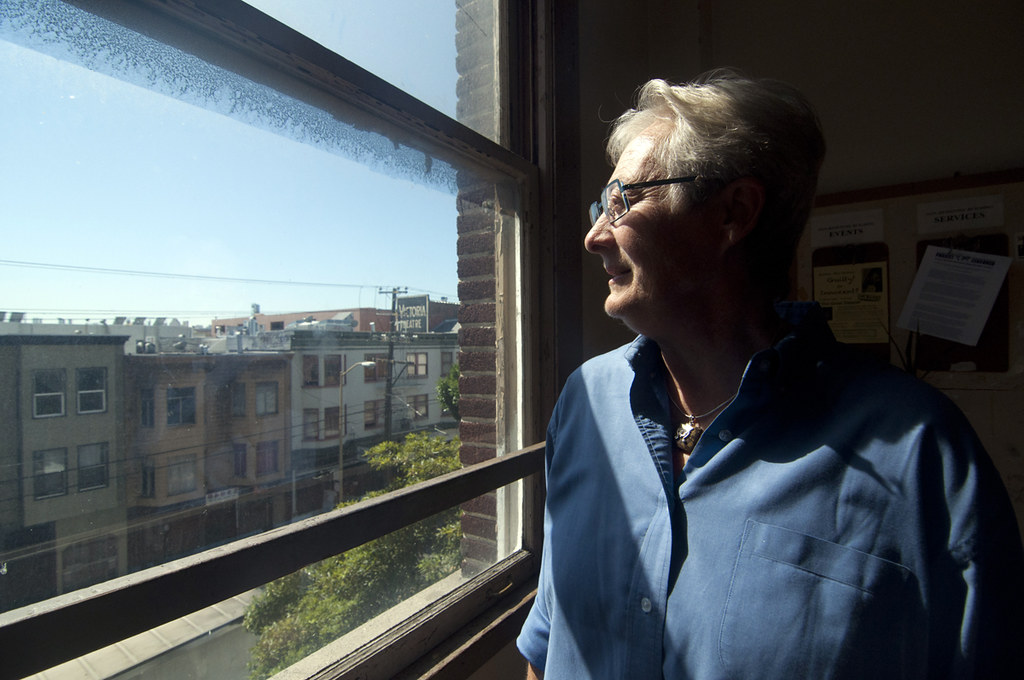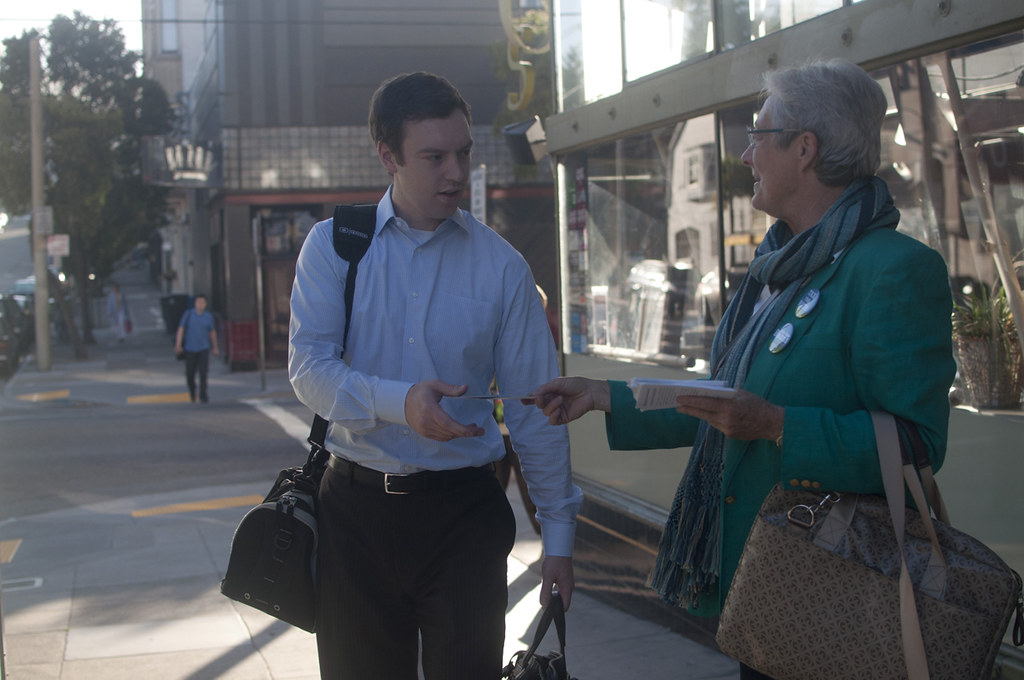By Chris Torres
Photos by Gregory Moreno
Big ideas are floating around San Francisco’s City Hall. Ideas like Central Subways, state pensions, Shark Fin Soup and America’s Cup. Impressive goals, but the economy and current mayoral candidates say most of the cash is spent.
The Board of Supervisors takes up much of San Francisco’s civic administration, but as mayoral candidate Terry Joan Baum describes it, the mayor’s office allows its holder to spearhead larger issues, especially in a city with such a progressive reputation. One of her first plans, if elected, is to reach out to the mayors of twenty of the nation’s other largest cities to discuss specific issues.
It’s September 9, and Baum is on her way to the PG&E headquarters to lead a demonstration against the energy giant on the anniversary of the 2010 San Bruno pipeline explosion. “PG&Evil,” one sign reads.

Visibility is important, so later, she’ll be in the Lower Haight. As mayor, Baum wants to spearhead the progressive issues that have helped to keep San Francisco in the political spotlight. She wants to reach out to the mayors of the nation’s top twenty largest cities to perhaps exact similar change at the national level. With sixteen candidates in the race, she knows her chances, but that won’t make her give up.
“I believe that the world needs San Francisco to lead again, right now,” Baum explains.
Baum ran against Nancy Pelosi for a seat in Congress in 2007, after Pelosi supported the Patriot Act and voted against the impeachment of President George W. Bush.
“I was driven to run because my representative did not represent me,” Baum says. She was arrested in the process, but did get her chance before the highest court in the land to have her name included on the ballot. She didn’t get the job, but Baum did receive the highest percentage of any third-party write-in vote for Congress in history.
Baum got an unlikely start in politics in 1970 while stuffing envelopes for Bella Abzug’s campaign for the New York House of Representatives. One of Abzug’s aides quit, no longer willing to shoulder the candidate’s busy schedule – or her volatility.
“[Abzug] had a nasty temper,” Baum recalls.

Instead of stuffing envelopes, Baum found herself at subway stations and on New York street corners, meeting voters and increasing her candidate’s visibility. It helped get Abzug into the New York House in 1971, and Terry Baum hopes the experience will get herself into the mayor’s office in November.
Back in San Francisco, Paul Currier is trying to get his campaign buses together, one of which is north of the Golden Gate and needs to be moved. His small apartment is doubling as an office, packed with papers, campaign buttons, literature, and a map of San Francisco with unmarked Post-It notes scattered around Pacific Heights. A little short-handed, his mayoral campaign has become more of a full-time, hands-on job than he ever anticipated.
“Nobody is working in my campaign but me,” he says without a hint of distress. He’s been using the internet to organize, and has been increasing his public visibility by showing up at any event he can get out to. He says that organization is the crucial to a successful campaign.
It’s hard to be visible when you’re not always invited to the community forums and mayoral debates. If they aren’t, Currier goes anyway, just like Baum did.

“The progressives are circling the wagons around [John] Avalos,” Currier says.
Like many progressive candidates, he’s not in favor of corporate tax breaks to encourage business to stay local and encourage development. He wants to see art replace blight—something most can agree with.
He went to UC Berkeley and has been homeless. The political turbulence of the 1970s made Currier decide he wanted nothing to do with politics. And for roughly 40 years, he didn’t. When Cindy Sheehan ran for a seat on the U.S. Congress in 2007, he returned to politics as a Field Coordinator for her local campaign, inspired by her bold positions during a period of such low public opinion of officials.
“I’m not a sellout; I’m not for sale,” he says.
Currier has one simple explanation for running: “If not us, who? If not now, when?” Now’s as good a time as any.
San Francisco is the first jurisdiction within the United States to use ranked-choice voting since Ann Arbor, Michigan used it unsuccessfully in the 1970s. Australia uses it to elect members of parliament, MVPs are chosen this way, and this year’s Academy Awards will be doled out via a ranked-choice vote.

A 2006 study of the November, 2005 San Francisco Assessor-Recorder race conducted by California FairVote representative and San Francisco resident Dr. Christopher Jerdonek, shows that the system not only improves voter turnout, but it drastically increases turnout in areas that otherwise had low voter turnout by “an estimated 2.7 [percent].” The report also found the most dramatic increase occurred in neighborhoods “generally recognized as among the most racially diverse and socioeconomically disadvantaged in San Francisco,” implying that ranked-choice voting might serve to boost voter turnout in general. The report does, however, note that this point “deserves further study and attention.”
It remains to be seen exactly how this will play out in a mayoral race that includes sixteen candidates. Also absent is concrete data detailing how San Franciscans adapted to and proceeded with the old system. San Francisco State University Political Science Professor Francis Neely coauthored a July 2006 study with Corey Cook that ultimately found the effectiveness of ranked-choice voting to be, as Neely describes it, “a trade-off.”
It’s happened before. Oakland’s 2010 mayoral election utilized ranked-choice voting and Jean Quan was swept into office ahead of first round front-runner Don Perata after her combined second and third choice votes totaled 2,025 votes higher than Perata’s first choice showing.
“It’s often the case that if you look at the number of votes cast for that office, and you look at the final number that the winner got after all the ranked-choice voting rounds and eliminations, that the winner got less than a majority of votes cast for that office,” said Professor Neely. That’s because some voters’ ballots are exhausted, or removed from the count, and in the final count a candidate ends up with more second and third-choice votes than the front-runner’s first-choice votes.
While San Francisco only allows voters to choose three candidates, there are usually many more than that in the race. If a voter has preference for candidates that are eliminated early in the count, or have a preference for only one candidate who doesn’t make it into office, their ballot would be considered exhausted.
With races for the Australian Parliament, if a voter does not rank each and every candidate in the race in order of their preference, their ballot would be automatically disqualified.
“In races where more money was spent,” Professor Neely explains. “People appeared to have more information and ranked three candidates more often.” The ballot itself can also sometimes cause errors in voting, which would disqualify them, Neely and Cook’s study found.
Portland, Maine is running an election this year using an altered version of the system. Portlanders are allowed to rank all candidates, but don’t have to if they don’t want to. The only limit on number of choices is the number of candidates, which means fewer ballot disqualifications.
Recent polls have shown Mayor Ed Lee to be the front-runner to San Francisco’s highest office. But with the introduction of ranked-choice voting to this year’s election, there’s a possibility that another candidate might secure a majority vote by amassing more second and third-choice votes.
Exit poll studies found that in both previous instances of this new voting system in San Francisco, respondents said they understood the system. However, only about 60 percent of participants knew that ranked-choice voting was going to be used at all. So it’s conceivable that many voters came to the booth without enough information to choose three candidates, leaving their ballot open to possible exhaustion in late-round counts.
While the ranked-choice system gives voters a wider choice in their selections, voters may not have the necessary information to rank three candidates along with their first choice. Bottom line is, while ranked-choice voting allows for a wider variety of choice and perhaps greater voter participation, its greatest hindrance is its relative complexity.
“There is no election system that produces a consistent, good, undeniable, unambiguous outcome,” Professor Neely explains. “When we aggregate preferences, we have problems.”
With ranked-choice voting, there’s room for a third party. The argument goes, if you’re a Green candidate like Terry Baum, you’re only taking votes away from progressive democrats or other, more popular candidates. Baum believes that without ranked-choice voting, she wouldn’t be in the race. Baum even urges her voters to consider putting her as their second choice and putting a more popular candidate above her. She suggests John Avalos as that choice.
With ranked-choice voting in place, “[political] endorsements don’t matter,” says Paul Currier. Regardless of how San Franciscans react to the system this November, ranked-choice voting is sure to give underdogs a better chance to finish near, or even at, the front.
Somebody will most definitely be elected come November. Regardless of who occupies the Mayor’s Office in January, the issues will be coming down the pipe. All that remains to be seen is City Hall room 200’s next occupant, and the path that brought them there.

